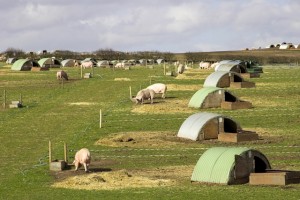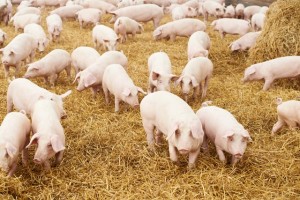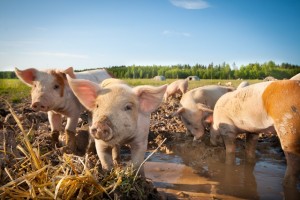Pig Diseases
Skin Conditions in Pigs
Includes the following conditions: External parasites, Greasy Pig Disease, Lice, Mange, Ringworm, Swine Pox and Ticks
A variety of diseases, parasites and disorders affect the skin of pigs, and can result in economic losses through sub-optimal growth rates (Cargill and Davies, 2001). Skin lesions can be the result of parasitic disease, infectious agents, physical damage by the environment or other pigs, and developmental causes. The risks to outdoor pigs are likely to be different to those suffered by pigs kept in enclosed environments.
In this section, the following skin conditions are considered:
- Greasy pig disease (Facial dermatitis/exudative epidermitis)
- Lice
- Mange
- Ringworm
- Swine pox
- Ticks
- Pityriasis rosea
- Flies
Greasy Pig Disease
Formally known as facial dermatitis, Greasy Pig Disease (exudative epidermitis) commonly affects neonatal piglets causing skin lesions on the cheeks, neck, ear tips and body. It also occurs in older age groups, particularly when pigs fight each other e.g. when they are mixed following weaning, or if there is limited access to water. Lesions begin with dullness of the skin combined with small, brown scales on the skin surface. These develop by spreading over a greater surface area, becoming darker in colour and releasing an exudate that gives the skin a “greasy” texture. As the scabs and exudate acquire dirt, the lesions gradually become black in colour. These lesions have an acute onset and can rapidly result in a depressed demeanor and dehydration if left untreated. In the worst cases piglets can die (Taylor, 2013). The organism linked to the disease is Staphylococcus hyicus, which commonly colonizes pig skin without causing disease (White, 2007). Unlike Sarcoptic mange, it is non-irritant. Damage to the skin, through fighting or collision, can trigger the disease. High humidity in buildings increases the risk of disease as S. hyicus proliferates on moist skin. The disease is linked to the incidence of competition and fighting amongst piglets (although it can affect all age groups) and the prevalence of mange (Potter, 1998).
A rare and fatal form of S. hyicus infection can occur in which the entire skin becomes thick and wrinkled. Euthanasia should be considered for animals with such a condition.
Click here to read about the treatment of greasy pig disease
Lice
Typically the most common louse found in pig herds is the large Haematopinus suis (5-6mm), found in skin folds around the neck and jowl, the ears, the legs and the flanks. The lice are a yellow-brown colour and can be seen with the naked eye, most clearly on white pigs. (Taylor, 2013).
Lice (along with mange) were the highest-ranking current health concern identified in a survey of UK organic pig farms (Day et al., 2003).
Click here to read about the treatment of lice in pigs
Mange
Mange is a parasitic disease of the skin caused by one of two mites either Sarcoptes scabiei var. Suis or Demodex phylloides. Sarcoptic mange (sometimes called Scabies) is present in almost all countries in the world where swine are raised, and it is considered the most important ectoparasite of pigs (Desrosiers, 2011). This burrowing mite is about 0.3-0.6mm in length and the entire lifecycle takes place on the pig, although mites have been shown to be capable of surviving off host for a few days. Sarcoptic mange results in skin lesions and discomfort for the animal, particularly around the eyes, snout, ears and hocks (Taylor, 1995). Intense itching is an important clinical sign associated with mange infestations. Mange can impact on production, with reduced growth rates and poor feeding efficiency, with reductions in growth rates of 4.5-12% possible in affected pigs (Zimmerman et al, 2012).
For herds with mange already present, risk factors for the spread of S. scabiei were found to be mixed housing of dry and nursing sows in the same unit (vs. separate housing) and straw bedding (vs. strawless) (Damriyasa et al., 2004).

There is less opportunity for the spread of mange in pigs living in outdoor ranges, due to reduced direct contact between pigs.
The mite spreads either by close contact with skin or contaminated surfaces. Breeding boars are chronic carriers and help to maintain infection in the herd (www.thepigsite.com ). Opportunities for spread in outdoor systems are likely to be reduced as sows are in less close contact than when in housed systems. In systems which adopt a closed herd policy the risk is further reduced. The common clinical signs of infection are ear shaking and severe rubbing of the skin against the sides of the pen. The pigs may also lose condition. The skin becomes sensitized to the mite protein and a severe allergy may develop 3-8 weeks after infection with very tiny red pimples covering the whole of the skin causing intense irritation, head shaking, the appearance of bare patches and possibly bleeding, caused by rubbing. As the infestation progresses the skin becomes thickened, crusted with exudates and secondarily infected due to damage caused by the host scratching (Taylor et al., 2007).
Click here to read about the treatment of mange in pigs
Ringworm
A fungal disease commonly found around the base of the ear and flanks. This is an uncommon condition in pigs but where it does exist it is of little economic significance (www.thepigsite.com ). It is caused by a Dermatophyte fungus causing gradually increasing circular areas of light to dark brown discoloration behind the ears and on the back and flanks. All ages of pig can be affected. It is also a zoonosis, i.e. stock persons may be at risk of acquiring an infection by being in contact with affected pigs.
Click here to read about the treatment of ringworm in pigs
Swine pox
The Swine Pox virus is widespread and infects swine through skin abrasions, causing circular red lesions on the flank, abdomen, face and head (Taylor, 1995). It affects all age groups although it is unusual in piglets however there is evidence to suggest it is a congenital disease (Thibault et al., 1998). The virus can survive outside the pig for long periods of time and is resistant to environmental changes.
It can also be spread by flies, lice or mange mites and can be consequential of skin damage caused by fighting or injury. Fresh oat straw has been incriminated because it can inflict superficial skin abrasions.
The lesions are small circular red areas of up to approximately 20 mm in diameter, that start as a vesicle containing straw-coloured fluid which ruptures within a few days to form a black scab. Secondary dermatitis may follow (www.thepigsite.com ).
Swine pox can be confused with localized greasy pig disease, pustular dermatitis and the allergic form of mange. It is important to note that for any disease that creates vesicular lesions, particularly around the mouth, nose, tongue or coronary band, Hoof and Mouth should be considered as a possible differential diagnosis. Swine pox does not usually focus on these areas, but if you are concerned, contact your vet immediately.
Click here to read about the treatment of swine pox in pigs
Ticks
Ticks can be a significant problem in the U.S.
Click here to read about the treatment of ticks in pigs
Pityriasis rosea
Pityriasis rosea is also known as pustular psoriaform dermatitis and appears as epidermal rings, mainly on the ventral abdomen and inner thighs. The disease is seen in young piglets, usually 3-14 weeks of age and although the exact cause is unknown, it does appear to be hereditary (Zimmerman et al, 2012). This section is still being prepared, with more information to follow, please check for updates.
Flies
Biting flies, usually the Housefly (Musca domestica) and the Stable fly (Stomoxys calcitrans), as well as screwworm flies (Callitroga spp.) commonly affect pigs, resulting in rubbing, scratching, alopecia, bleeding and excoriations, as well as raised wheals and edema associated with urticaria. (Zimmerman et al, 2012). This section is still being prepared, with more information to follow, please check for updates.
General clinical signs associated with skin conditions
Although severe lice and mange can lead to loss of condition in animals, signs are usually limited to itchy, sensitive patches on the skin, which cause animals to scratch and rub the affected area, take on a hairy appearance, and possibly then develop visible lesions, welts and scabs.
Characteristic circular lesions indicate the presence of ringworm.
Control and Prevention of Skin Conditions

Most skin conditions can be controlled by good hygiene, sanitation and biosecurity. Housing should be kept clean and dry and be regularly disinfected.
Most skin conditions can be avoided through good hygiene and sanitation. Outdoor conditions are less conducive to transmission between animals than those in indoor units, but housing should be kept clean and dry, and periodically disinfected.
Control of Greasy Pig Disease
Greasy Pig disease may be associated with mange, but also affects piglets with abrasions on the neck and cheeks due to fighting (Potter, 1998). Management of litters and fostering in larger litters may reduce this complication. Abrasions may also result from poorly maintained huts and arks, and sharp edges on all equipment should be avoided (Cameron, 1999). Poor hygiene and husbandry have also been implicated (Zimmerman et al, 2012). Biotin and vitamin B supplements may help control dermatitis (Cameron, 1999).
Greasy Pig disease is best controlled through identification of the causal factor – excessive fighting in litters (Potter, 1998). Tooth reduction (by clipping or grinding) is often recommended to avoid damage caused by fighting. However, the underlying causes of aggression should be addressed before tooth reduction is initiated.
Control of Mange and Lice
A closed herd policy will help to keep mange off the farm, but as gilts and boars are likely to be bought into most pig enterprises, purchase from mange-free herds or careful checking and possible treatment against mange is recommended before inclusion of new animals into the main herd.
Mange and lice may be prevented with careful sanitation in arks and huts, and regular removal and/or burning of bedding, especially where infestations have been found (Potter, 1998). Affected animals should be treated immediately to avoid suffering.
To prevent introduction of the pathogen agent, strict biosecurity measures must be enforced (people access, transportation etc.).
See Sarcoptic mange at www.thepigsite.com for a comprehensive section on control focusing on three aspects:
- Maintaining a parasite free herd
- Controlling the parasites
- Eradication
Control of Ringworm
The spread of ringworm may be associated with contaminated bedding and rodents, and hence vermin control will help in preventing spread. Active control as well as careful sanitation and destruction of old bedding will reduce incidence (Cameron, 1999).
Control of Swine pox
Swine pox has limited impact in terms of morbidity or mortality, and is of limited significance. Good hygiene and the control of lice may help prevent the condition (Cowart and Casteel, 2001).
Treating Skin Conditions
Treating Greasy Pig Disease
Clinical disease may be treated with antibiotics when severe. It is important that the antibiotic is effective against the bacteria involved. Lincomycin, the penicillins and cephalosporins are generally the most effective injectable treatments. It is also important that sufficient dose is given for the correct duration. Treatment should be started early (White, 2007). Young pigs suffering from Greasy Pig Disease should also be hydrated using an electrolyte solution.
There are no suitable topical treatments licensed for use in the UK. A dilute antiseptic solution may be a useful skin treatment, killing bacteria and removing the greasy layer from skin.
Piglets with damaged faces are usually receiving insufficient milk and must be fostered onto a better teat on another sow. This requires good stockmanship, particularly in a situation where teeth clipping is not allowed.
Treating Lice
Animals clinically affected with lice should be treated immediately. An injectable Avermectin has proved highly effective as a single treatment (Taylor et al., 2007), however for pigs close to slaughter meat withdrawal needs to be considered. Once lice have been diagnosed it is essential to treat the whole herd.
For louse infestation, only mechanical cleaning of stable units (vs. additional use of disinfection methods) and pasturing of gilts and dry sows were identified as risk factors for louse infection in pigs (Damriyasa et al., 2004). The adult lice cannot survive for very long off the host, but the eggs can survive in bedding.
Treating Mange
Animals clinically affected should be treated without delay. An avermectin should be used as per lice above. Ideally, the treatment should involve at least two treatments 14 days apart to manage any adult mites that have hatched after the first treatment, as at present there are no long-acting avermectins licenced for use in pigs in the UK.
A herbal miticidal preparation of Neem oil, Karanj oil and Camphor have been shown to be effective in controlling Sarcoptes scabiei in India (Kumar et al., 2005).
Preparations of the medicinal plant extracts hogweed, mugwort, tansy and wormwood and the essential medicinal ethereal oils of garlic, black pepper, juniper, citronella grass, pennyroyal, eucalyptus and tea tree have all been shown to inhibit the development of, and were more or less lethal to, mange mites. Tea tree and citronella volatile oil preparations were the most effective (Mägi et al., 2006). Whilst these complementary therapies have been shown to be very effective, due to the fact that mange can become a major welfare issue if left unchecked, it is important to consult your veterinarian if an outbreak occurs.
Treating Ringworm
Ringworm is a self-limiting disease (Potter, 1998), but severe infestation can be treated with disinfectant or copper sulphate (Cameron, 1999; Taylor, 1995). Enilconazole is not licensed for use in pigs in the UK, but is licensed for use in cattle, it could therefore be used under the rules of the Veterinary Medicines Directorate (VMD) cascade. However, this would likely carry a 28 day meat withhold period, so this needs careful consideration before use. Your veterinarian can provide further information. Treatment involves washing the infected area with a 1% savlon or hexetadene skin disinfectants or fungicides.
Treating Swine pox
No treatment is available for swine pox, and its impact on the animal is limited (Taylor, 1995). Animals tend to self-heal within three weeks of infection.
Treating Ticks
Small scale infestations can be removed manually in combination with removal of pigs from the contaminated pasture (Straw et al, 2006). There are no topical or parenteral treatments licensed for use in the UK.
Skin Conditions and Welfare
Skin complaints, while not always having major productivity implications, are the cause of significant discomfort amongst stock, and for that reason steps should be taken to prevent and control conditions. If not addressed promptly, disease can potentially become severe, leading to secondary infections and requiring the use of antibiotics. Mange and lice, in particular, should be treated as soon as the infestation is noticed, to avoid further spread and to spare individual animals severe discomfort.
Good Practice based on Current Knowledge
- Follow good biosecurity practices
- Maintain high levels of hygiene at all times. Removing and destroying used and infected bedding and regularly cleaning arks and particularly farrowing huts between litters will reduce incidence and spread of infectious skin diseases
- Stocking rates amongst litters and piglets should be managed to minimize aggressive behaviour and resulting abrasions on the skin of young stock
- Where a closed herd policy cannot be practised, all purchased stock should come from mange- and lice-free holdings or should be treated for these conditions before inclusion into the main herd
- Huts and other equipment should be carefully maintained, and sharp edges removed
- Rodent populations should be controlled near the outdoor site


 British English
British English


Comments are closed.